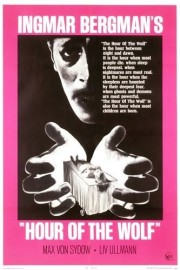Hour of the Wolf
As the credits roll, we hear the sounds of work on a film set, finishing with “Rolling! Take!” as the screen fades to black. Before the credits, we’ve seen title cards explaining how the wife of an artist, who drove himself mad when his art failed, has given the filmmakers his diary on which to base their film. We then see Alma (Liv Ullmann), the wife, addressing the camera, trying to make sense of what happened to her husband Johan (Max von Sydow) that forced him to go mad. Then, the story begins proper.
In a way that only an artist like Ingmar Bergman would attempt, this brief prologue is the filmmaker’s homage to the opening of James Whale’s “Bride of Frankenstein,” which imagined author Mary Shelly devising a continuation to her original tale, which allowed what came after to be seen through the eyes of pure artifice, even as Whale’s personal attachment to the material made it seem as real an emotional experience as we’ve ever seen in a horror film.
As the film progresses, however, and Alma and Johan grow into a routine on the island they’ve come to stay at over the summer, another film came to mind. Like Bergman’s haunting film (my personal favorite of his, although “The Magic Flute” and “Scenes From a Marriage” and its’ late-career companion “Saraband” aren’t far behind), Stanley Kubrick’s “The Shining”- perhaps inspired by Bergman’s film as much as Stephen King’s novel- also shows an artist descending into madness, and the wife who doesn’t know how to handle it. But whereas isolation and past events brought out the psychological demons the Torrences go through, a dinner party with the owners of the island is the breaking point for Johan, who is getting over a dangerous illness. His wife is helpless, only capable of watching him retreat further into himself.
Although both films contain suspenseful moments that bring forth genuine terror in the audience, it’s the filmmaker’s delving into the main character’s psychological makeup that makes each film genuinely terrifying. Both Johan and Jack (Jack Nicholson) are haunted by violent moments with children; both are beset by ghosts (Johan’s more in personal scandal, Jack’s more in supernatural manifestations). And neither can get much rest. Jack’s only peace is when he’s outlining his new “book”; for Johan, the “hour of the wolf”- said to be the hour when most people die, and most children are born- is a time when the past most comes alive, leaving him restless. Alma stays up with him one such evening, and the revelations shake them both to their core.
From that point, Johan goes on a surreal journey of temptation and danger, leading to the final frames, where his past gets the best of him, leaving Alma alone, confused about her feelings for him and what he’d done. Unlike Kubrick, however, Bergman was always looking for redemption, even when he told a story as dark and terrifying as this one is.










